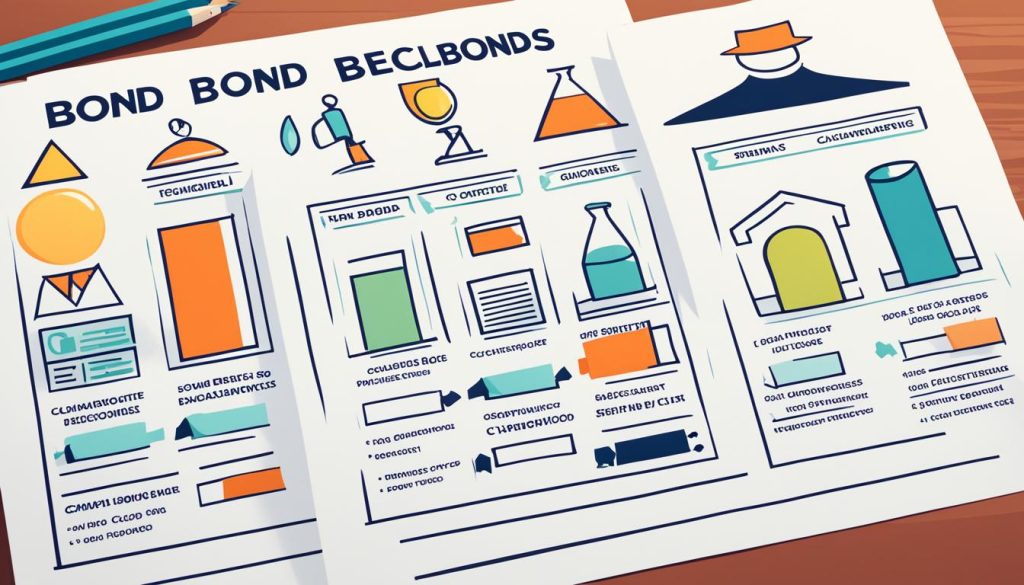Dealing with legal issues can feel like a heavy burden. It’s important to know the difference between bail and bonds. Bail lets a defendant get out of jail while they wait for their trial. A bond is when a bail bondsman pays the bail for the defendant1.
The court sets the bail amount looking at the defendant’s past crimes, the seriousness of the charges, and if they might skip town1. You can pay bail with cash, property, or even promise to show up in court2. Bonds usually mean hiring a bail bondsman who takes a cut to get you out2.
Key Takeaways
- Bail is a financial arrangement that allows a defendant to be released from custody while awaiting trial.
- Bonds are a financial guarantee provided by a bail bondsman on the defendant’s behalf.
- Bail amounts are determined by the court based on factors like the defendant’s criminal history and the likelihood of fleeing.
- Bail can be paid in cash, through a property bond, or via personal recognizance.
- Bail bond companies typically charge a non-refundable fee of 10-20% of the bail amount.
Introduction to Bail and Bond
Learning about the bail and bond process is key when dealing with the criminal justice system. Bail is a financial deal that lets a defendant get out of jail while they wait for trial3. The court sets a bail amount based on several factors. The defendant can pay it in cash, use a property bond, or be released on their promise to show up in court.
Bail: A Financial Arrangement for Release
Bail helps a defendant get out of jail before their trial. The court looks at the crime’s seriousness, the defendant’s chance of fleeing, and their past crimes to set the bail4. After paying the bail, the defendant is free and must go to court when needed.
Bonds: A Bail Bondsman’s Guarantee
Bonds are different from bail. They involve a bail bondsman who pays the bail for the defendant, for a fee3. In California, the cost of a bail bond is usually ten percent of the total bond, plus any extra costs3. Bail bondsmen in California must have a license and carry insurance of at least one million dollars for injuries, death, or damage to property3.
Bail and bonds are key in the criminal defense process. They let defendants stay free while they wait for trial and meet their legal duties. Knowing the differences between these is vital for understanding the bail and bond process5.
Types of Bail
There are several ways to get a defendant out of jail while they wait for trial. Knowing about these bail options can help people navigate the legal system better. Let’s look at the main types of bail and what makes them different:
Cash Bail
Cash bail means the defendant pays the full bail amount to the court. This ensures the defendant will show up for court dates. If they do, they get their money back, minus any fees6. In California, a judge sets the bail based on the defendant’s past, risk of fleeing, and the seriousness of the charges6.
Property Bond
A property bond uses assets like a house or car as collateral. It’s often cheaper than cash bail, needing only part of the total bail upfront7. Getting a property bond can take time because of inspections and paperwork7.
Personal Recognizance
Personal recognizance lets the defendant go free without bail, promising to appear in court7. This is up to the arresting officer or the court7.
Knowing about the different bail options and their rules can help people make better choices during the legal process6. Hiring a bail bondsman is a common and cheaper way for many to get a loved one out of jail6.
| Bail Type | Description | Refundability |
|---|---|---|
| Cash Bail | Defendant pays the full bail amount directly to the court. | Refundable, minus fees |
| Property Bond | Defendant uses assets like a house or car as collateral. | Refundable, minus fees |
| Personal Recognizance | Defendant is released without the need for bail, based on their commitment to appear in court. | No payment required |
In California, most arrested people can get bail, allowing them to be released while waiting for trial6. Bail might not be given in some cases, like serious charges or a big flight risk6.
“Understanding the different bail options can help defendants and their loved ones make informed decisions during the criminal justice process.”
Looking into the various bail types and their features helps people make better choices for getting a loved one released. This ensures they meet their legal duties687.
Types of Bonds
There are many types of bonds used to get someone out of jail. It’s important to know the differences to move through the legal system well. Let’s look at the main types of bonds.
Cash Bond
A cash bond means the defendant or their family pays a bail bondsman a fee, usually 10-20% of the full bail9. This money is paid right away and is lost, no matter what happens in court.
Property Bond
A property bond uses property as collateral for the bail9. This can take a while because of inspections and paperwork to check the property’s value9.
Immigration Bond
Immigration bonds are for non-citizens held by immigration authorities9. These bonds can be tricky because of the complex laws and rules for international cases.
Federal Bond
Federal bonds are for cases of federal crimes9. They work like regular bonds but are for the federal courts.
Understanding the different bonds can be hard, but knowing the main differences helps. It makes choosing the right option easier and helps with a smoother legal process1011.

“The bail system can be complex, but the primary goal is to ensure individuals appear for their court dates while also balancing the rights of the accused and the interests of the community.”
bail, bond, criminal cases, legal process
Understanding the legal system can be tough, especially with bail and bond. These financial deals are key in the criminal justice process. They decide if someone can be released while waiting for trial12.
After an arrest, a judge or officer sets the bail or bond terms. Bail is a promise that the defendant will show up for court13. Bonds are different. They involve a bail bondsman who pays the court a fee, usually 10% of the bond14.
The bail amount depends on things like the defendant’s risk of fleeing, the crime’s seriousness, and the danger to others13. Felony bail can be over $20,000, while misdemeanors might be around $50012.
If someone doesn’t show up to court, they could lose their bail and face more charges12. But, if they meet all their court duties, they might get their bail money back12.
Knowing about bail and bond is key for those facing criminal charges. It can greatly affect their legal journey. By understanding these terms, people can make better choices and handle the legal process better12.

“Bail and bond are key parts of the criminal justice system. They make sure defendants show up for trial and respect the idea of being innocent until proven guilty.” –13
Bail vs. Bonds: Key Differences
When you’re facing criminal charges, knowing the difference between bail and bonds is key. The main differences are in how you pay and who gets involved15.
Financial Aspect – Payment and Refundability
With bail, you or your family must pay the full bail amount set by the court. If you show up for all your court dates, you might get your money back15. Bonds work differently. A bail bondsman takes a non-refundable fee, usually 10-20% of the bail, and covers the risk if you don’t show up15.
Responsibility and Involvement of a Third Party
Bail is a direct deal between you and the court. You’re on your own to make sure you’re there for court15. Bonds need a third-party bail bondsman to step in and promise you’ll be there15. This can be cheaper for those who can’t pay the full bail16.
| Bail | Bonds |
|---|---|
| Defendant or family pays full bail amount | Bail bondsman charges 10-20% non-refundable fee |
| Bail amount can be refunded if defendant appears | Bondsman assumes financial risk if defendant fails to appear |
| Direct financial arrangement between defendant and court | Involves a third-party bail bondsman |
“Bail is the amount set by the Judge for the defendant to pay for release from jail, while a bond is a contractual agreement with a bonding company to secure the defendant’s release.”16
Knowing the differences between bail and bonds helps you make better choices in the criminal justice system15. It’s smart to talk to a criminal defense lawyer about bail or bond options15.
The Role of Bail Bondsmen
Bail bondsmen, also known as bail bond agents, are key in the bail bond process. They make a promise to the court, promising to pay the full bail if the defendant doesn’t show up17. They charge a fee, usually 10-15% of the bail, and might ask for collateral like property1819.
If the defendant skips court, the bail bondsman can hire a bail recovery agent to find and bring them back17. This action, called “skipping bail,” can lead to losing the bail bond and more legal trouble for the defendant19.
Bail bondsmen must know the laws, assess risks, secure collateral, make sure defendants go to court, and handle bail forfeitures if needed18. They are crucial in the criminal justice system. They provide financial guarantees that defendants will attend court and help those who can’t pay full bail19.
| Type of Bail Bond | Typical Premium Paid | Refundability |
|---|---|---|
| State Bail Bond | 10-15% of total bail amount | Partially refundable if defendant appears in court |
| Federal Bail Bond | 10-15% of total bail amount | Non-refundable |
Debates like California’s Senate Bill 10 show the challenges in balancing safety with fairness for accused people17. Bail bondsmen are still key in the criminal justice system. They offer a vital service for those who can’t pay full bail19.
“Bail bondsmen are an essential part of the criminal justice system, helping those who cannot afford the full bail amount to be released from custody while awaiting trial.”
The role of bail bondsmen is complex. They provide financial guarantees, assess risks, manage collateral, and ensure defendants go to court. Their services are vital for those who can’t pay full bail. Yet, the debate on bail reform keeps changing the bail bond industry171819.
Conclusion
Dealing with criminal cases can be tough, but knowing the difference between bail and bonds is key. Bail means paying the full court-set amount to get out of jail. Bonds let a third-party bail bondsman pay for you with a non-refundable fee20.
Understanding your rights and options helps you make smart choices. Bail bonds let you stay free while you wait for trial, which can take a long time21. Getting a bail bond involves arrest, bail hearing, applying for the bond, posting bail, following bail rules, and going to court21.
Learning about bail and bonds helps you handle criminal cases better. Bail bonds are important for a fair legal process. They balance your right to freedom with the state’s need for you to appear in court21.
FAQ
What is the difference between bail and a bond?
Bail lets a defendant get out of jail while waiting for trial. A bond is when a bail bondsman pays the bail for the defendant.
How is the bail amount determined?
The court looks at the defendant’s past crimes, the seriousness of the charges, and if they might skip trial. Then, it sets the bail amount.
What are the different types of bail?
There are three main types of bail: cash bail, property bond, and personal recognizance.
What are the different types of bonds?
Common bonds include cash bond, property bond, immigration bond, and federal bond.
What happens if a defendant fails to appear in court?
If a defendant doesn’t show up in court, the bail is lost. They could also face more charges for skipping bail.
What is the role of a bail bondsman?
Bail bondsmen promise the court the defendant will show up. They charge a fee, usually 10-20% of the bail, and might ask for collateral.

